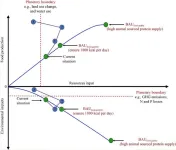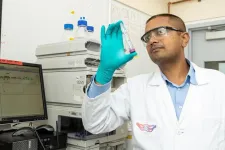(Press-News.org) Why do some young children struggle to sit through a story one day but not the next? Why do they rush impulsively into one activity but not another? Parents and teachers often focus on individual differences as they prepare children for formal schooling, but traditional measurement approaches make it difficult to study fluctuations in children’s behavior.
In a new study, researchers sought to understand children’s impulsive and inattentive behaviors in early education classrooms by having students use wearable devices called accelerometers to collect an intensive time series of their movement at school. The study found that children modulated their behavior across periods of the school day and their self-regulation declined across the school week. In addition, children with greater self-regulation were more consistent in applying it across school days.
The study, by researchers at the University of Pennsylvania and the University of Texas at Austin, appears in Child Development, a journal of the Society for Research in Child Development.
“When a child has difficulty sustaining attention or sitting still, it disrupts their learning and can disrupt the classroom,” explains Andrew Koepp, a postdoctoral scholar in psychology at the University of Pennsylvania and the study’s lead author. “Research has consistently found that difficulties controlling attention and behavior in childhood predict more difficulties later in life, such as lower educational attainment and more financial problems.”
Parents’ and teachers’ reports of children’s behavior are subjective and general, rather than specific. Observations in schools and the lab require substantial time and resources, and usually fail to capture ranges of behavior. Wearable devices record data continuously and unobtrusively over a period of days, making them useful in collecting repeated observations.
In this study, researchers sought to capture children’s behavior directly rather than relying on teachers’ recall of that behavior, hypothesizing that impulsive and inattentive behaviors would be identifiable through intensive observations of their gross motor activity at school.
By having the children wear accelerometers, researchers collected 2.7 million observations of about 60 children (ages 3 to 6, primarily white and of high socioeconomic status) enrolled in five preschool or kindergarten classrooms at a university laboratory school in central Texas in the fall of 2021; they also asked teachers about children’s behaviors and movement. Machine learning analyses indicated that children’s typical forward acceleration correlated strongly with lower teacher-reported inhibitory control and attention.
Impulsivity and inattention are believed to emerge from a lack of self-regulation—a broad term for a set of dynamic processes that facilitate the adaptive control of thoughts, emotions, and behavior through both central nervous systems and physiological systems. Using forward movement intensity as a proxy for self-regulation, researchers partitioned the intensive time series to find that:
Children modulated their behavior across periods of the school day,
Children’s self-regulation declined across the school week, supporting the idea that self-regulation is a resource that can be depleted through repeated use in everyday settings like school, and
Children with greater self-regulation showed greater consistency in applying it across days.
In addition, the study found that the onset, intensity, and duration of children’s gross-motor, full-body movement through space was strongly associated with teachers’ reports of children’s self-regulatory behavior in the classroom. The best predictor was one that captured sustained acceleration (combining onset, duration, and changes in intensity). Surprisingly, sustained acceleration was more strongly related to inhibitory control and attention than to impulsivity.
“Our study showed that wearable technology can automate the detection of impulsive and inattentive behaviors, facilitating within-child investigations of children’s self-regulation,” says Elizabeth Gershoff, professor of human development and family sciences at the University of Texas at Austin, who coauthored the study. “We also showed that children’s motor actions reveal mental processes that are not directly observable.”
The authors suggest that tools like the ones they used can yield insights to assist parents and teachers in helping children develop the skills to control their attention and behavior so they can pursue goals and interests. For example, it may be useful for educators to understand that young children may be most calm and ready to learn earlier in the school week and encourage them to adopt a strengths-based approach that focuses on times when children can regulate behavior.
This research was supported by the National Academy of Education/Spencer Foundation, the University of Texas at Austin, the Eunice Kennedy Shriver National Institute of Child Health and Human Development, the National Science Foundation and the University of Pennsylvania.
###
Summarized from Child Development, “Leveraging an Intensive Time Series of Young Children’s Movement to Capture Impulsive and Inattentive Behaviors in a Preschool Setting,” by Koepp, A.E. (University of Pennsylvania), and Gershoff, E.T. (University of Texas at Austin). Copyright 2024 The Society for Research in Child Development. All rights reserved.
END
Nature-based climate solutions can help mitigate climate change, especially in forested regions capable of storing and sequestering vast amounts of carbon. New research published in Global Change Biology indicates that a single hurricane in New England, one of the most heavily forested regions in the United States, can down 4.6–9.4% of the total aboveground forest carbon, an amount much greater than the carbon sequestered annually by New England’s forests.
The work revealed that emissions from hurricanes are not instantaneous—it takes approximately 19 years for downed carbon to become a net emission, and 100 years for 90% of the downed carbon ...
Essential tremor, a nervous system disorder that causes rhythmic shaking, is one of the most common movement disorders. A new study published in the Annals of Neurology reveals details on the increased risk of mild cognitive impairment (MCI) and dementia that individuals with essential tremor may face.
The research represents the longest available longitudinal prospective study of rates of MCI and dementia in people with essential tremor. The study enrolled 222 patients, 177 of whom participated in periodic evaluations over an average follow-up of 5 years.
Investigators observed ...
A new study has found that Black women with poor cardiovascular health may face an elevated risk of early signs of cognitive decline in midlife.
The study, which is published in the Journal of the American Heart Association, included 363 Black and 402 white women who enrolled in the Chicago site of the Study of Women’s Health Across the Nation when they were 42–52 years old. Cognition (measured as processing speed and working memory) was assessed annually or biennially over a maximum of 20 years, with an average follow-up of 9.8 years. A composite index of cardiovascular health (Life’s Essential 8) was calculated ...
The beginning of life is shrouded in mystery. While the intricate dynamics of mitosis is well-studied in the so-called somatic cells – the cells that have a specialized function, like skin and muscle cells – they remain elusive in the first cells of our bodies, the embryonic cells. Embryonic mitosis is notoriously difficult to study in vertebrates, as live functional analyses and -imaging of experimental embryos are technically limited, which makes it hard to track cells during embryogenesis.
However, researchers from the Cell Division Dynamics Unit at the Okinawa Institute of Science and Technology ...
COLUMBUS, OHIO – A new national survey conducted by The Ohio State University Wexner Medical Center finds a broad majority of parents experience isolation, loneliness and burnout from the demands of parenthood, with many feeling a lack of support in fulfilling that role.
The survey of parents conducted this month found:
About two-thirds (66%) felt the demands of parenthood sometimes or frequently feel isolating and lonely.
About 62% feel burned out by their responsibilities ...
Traditional non-aqueous lithium-ion batteries have a high energy density, but their safety is compromised due to the flammable organic electrolytes they utilize.
Aqueous batteries use water as the solvent for electrolytes, significantly enhancing the safety of the batteries. However, due to the limited solubility of the electrolyte and low battery voltage, aqueous batteries typically have a lower energy density. This means that the amount of electricity stored per unit volume of aqueous battery is relatively low.
In a new study published in Nature Energy, a research group led by Prof. LI Xianfeng from the Dalian Institute of Chemical Physics (DICP) ...
Contemporary food systems were originally developed to tackle challenges of the mid-20th century, aiming to supply abundant, efficient, non-perishable starchy calories to accommodate the expanding global population. Although substantial progress has been made in global food security over the past several decades, there still exist large populations experiencing hunger worldwide. Currently, global hunger primarily refers to insufficient calorie intake. Hidden hunger is the presence of multiple micronutrient in the absence of an energy-deficit diet. Hidden hunger, particularly the inadequate consumption of high-quality protein, ...
An international team of researchers, led by Danielle DeLeo from the Smithsonian Institution, has identified eight organisms with previously unknown luminosity. Using genetic findings from these organisms and previous studies, they estimated that coral bioluminescence originated about 540 million years ago in the Cambrian period, making them the earliest bioluminescent organisms. During this period, they shared the oceans with invertebrates with light-sensitive eyes, hinting that interspecies interactions occurred involving light. They published their findings in Proceedings of the Royal Society B.
While shallow-water ...
SRI announced today that it has been selected by the Defense Advanced Research Projects Agency (DARPA) to deliver advanced technology for its recently launched Multiobjective Engineering and Testing of ALloy Structures (METALS) program.
DARPA METALS aims to break today’s one-material-per-part paradigm, which can lead to vulnerabilities and reduced life when highly engineered components experience austere environments. The goal of the four-year program is to develop technologies that treat material selection – particularly metallic alloys – as a continuous ...
Vaccines remain the gold standard of protection against dangerous pathogens, but take considerable time and vast resources to develop. Rapidly mutating viruses such as SARS-CoV-2 can blunt their effectiveness and even render them obsolete.
To address these gaps, a multi-university team led by New Jersey Institute of Technology’s Vivek Kumar is developing a hydrogel therapy that acts as a first line of defense against viruses and other biological threats. The peptides that make up this gel prevent viruses ...




